How Gerrymandered Are State’s Congressional Districts?
And how much can they be improved by fair maps?
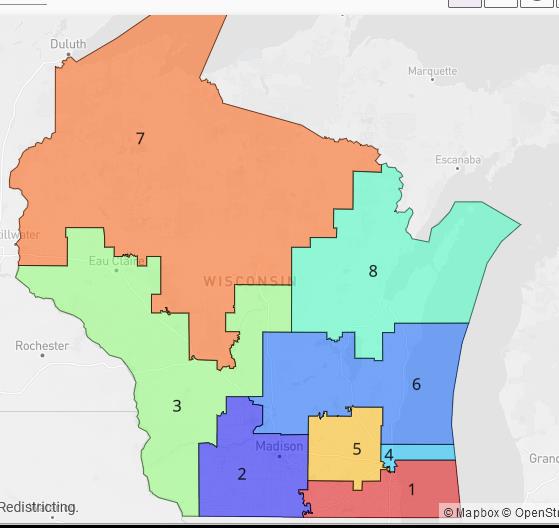
Wisconsin Congressional Districts
In her dissent attacking her colleagues’ decision to throw out Wisconsin’s legislative district maps that were adopted in 2022, state Supreme Court Chief Justice Annette Ziegler complained that the map for Congressional districts was left unchanged: “A majority of the court accordingly adopted Democratic Governor Evers’ proposed congressional map as the remedial map. Curiously, no challenge is made to that Democratically drawn map which was chosen with the ‘least change’ methodology. Could it be that it already achieves the desired partisan outcome?”
It appears that Ziegler may get her wish. A petition to the Wisconsin Supreme Court proposes that the court rule against the current maps for Wisconsin’s eight-member congressional delegation.
Authors of this petition come from two law firms: Washington’s (and Seattle’s) Elias Law Group and Madison’s Pines Bach. Marc Elias and Lester Pines, the principals of each are well-known as opponents of partisan gerrymandering.
There is no question that the map for congressional districts is an extreme gerrymander favoring Republicans. Wisconsin’s statewide elections are closely divided between Democrats and Republicans. One would expect that the Congressional delegation would reflect that division. Yet, only two of the eight districts are currently occupied by Democrats.
As the next graph shows, Wisconsin currently has four safe Republican seats (districts 5 to 8) and two safe Democratic seats (districts 2 and 4). Districts 1 and 3 are competitive but currently occupied by
by Republicans. The estimates below of the partisan makeup of each district comes from the respected website Dave’s Redistricting and use an average of election results from 2016 to 2022 for presidential, U.S. Senator, governor and attorney general races.
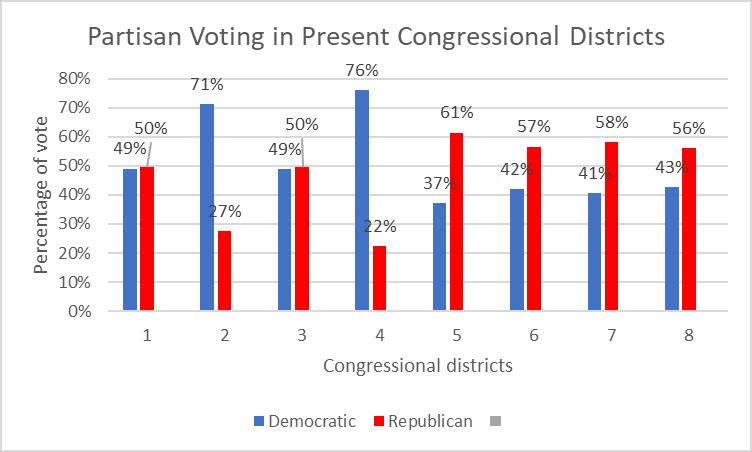
Partisan Voting in Present Congressional DistrictsThe map below shows the current Congressional seats. Again, the only two majority Democrats are District 2, centered on Madison, and 4, mostly Milwaukee.

Wisconsin Congressional Districts
Certainly, it is possible to draw Congressional districts maps that better reflect Wisconsin voting patterns. Consider the map below, called “Kevin’s Wisconsin.” I chose this map because Dave’s Redistricting rated this the most proportionate of all the Wisconsin congressional maps that were submitted to it.
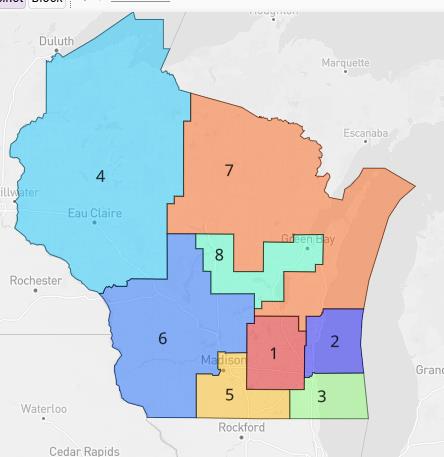
Kevin’s Wisconsin
As the next graph shows, this creates four majority Democratic districts (2, 3, 5, and 6) and four majority Republican districts (1, 4, 7, and 8).
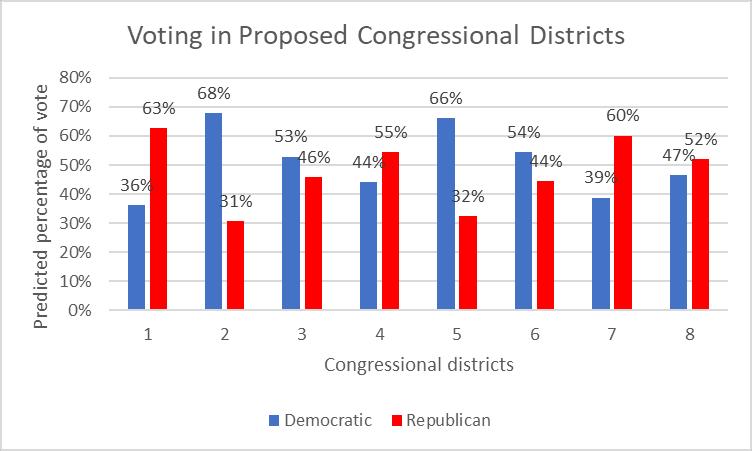
Voting in Proposed Congressional Districts
In addition to proportionality, Dave’s Redistricting also rates maps by competitiveness, minority representation, compactness, and the number of counties that are split on a scale of zero to one hundred where bigger is better. As the graph below shows, Kevin’s Wisconsin map also rates best on compactness and better than the present map on splits.
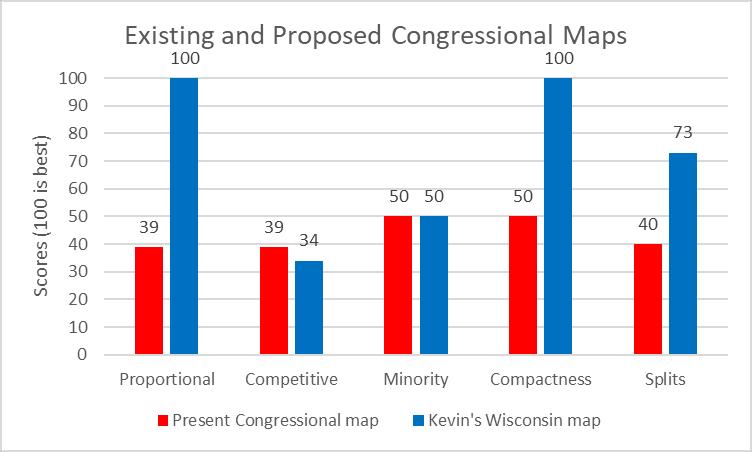
Existing and Proposed Congressional Maps
The next graph shows four of the measures used to measure disproportionality. Although each measures it differently, they all tell the same story.
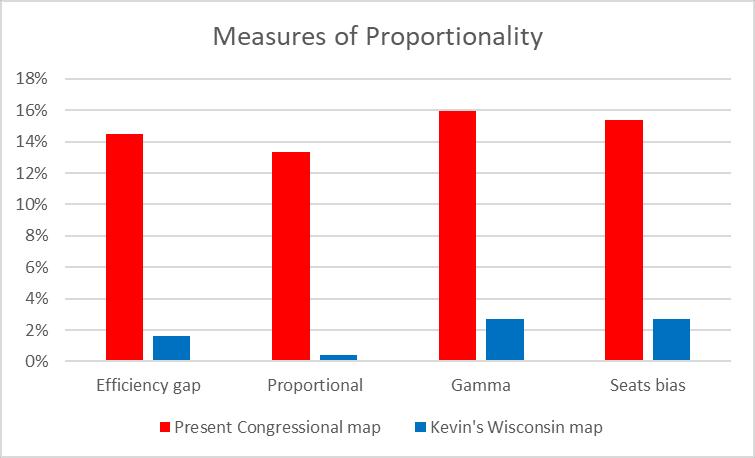
Measures of Proportionality
Thus, Kevin’s Wisconsin map demonstrates that there is room for enormous improvement in the map of Congressional districts. That does not mean that there is no room for further improvement. For instance, I wonder if it is possible to adjust Kevin’s map to increase the number of competitive districts.
In 2022, the then court majority voted to perpetuate that advantage for another 10 years. In effect, the Republican Legislature’s highly partisan map became the court’s highly partisan map.
The fact that the three dissenters were widely considered to be the court’s conservatives and derived their election support largely from Republicans and Republican allies leads to the suspicion that the true motivation for their opposition is a desire to perpetuate that GOP advantage.
If you think stories like this are important, become a member of Urban Milwaukee and help support real, independent journalism. Plus you get some cool added benefits.
Data Wonk
-
Why Absentee Ballot Drop Boxes Are Now Legal
 Jul 17th, 2024 by Bruce Thompson
Jul 17th, 2024 by Bruce Thompson
-
The Imperial Legislature Is Shot Down
 Jul 10th, 2024 by Bruce Thompson
Jul 10th, 2024 by Bruce Thompson
-
Counting the Lies By Trump
 Jul 3rd, 2024 by Bruce Thompson
Jul 3rd, 2024 by Bruce Thompson

















